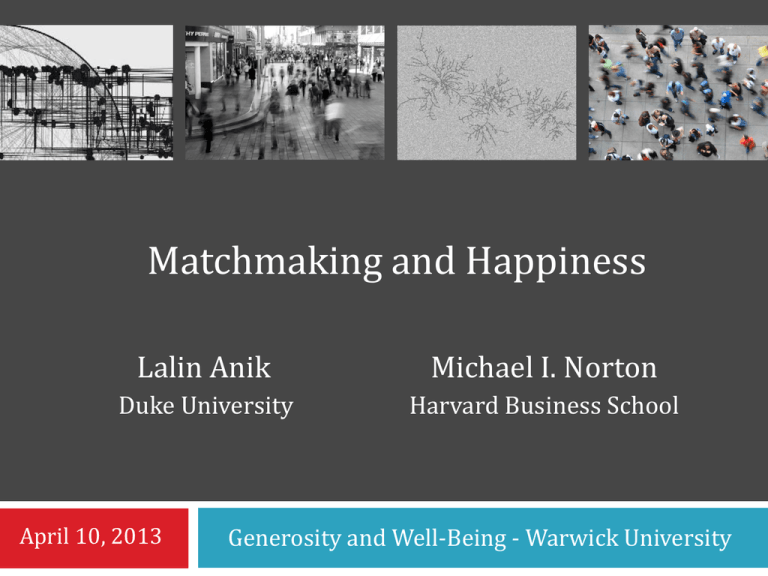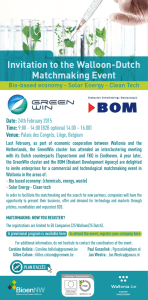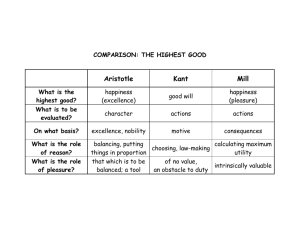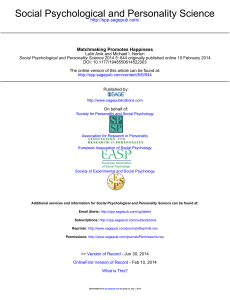
Matchmaking and Happiness
Lalin Anik
Michael I. Norton
Duke University
Harvard Business School
April 10, 2013
Generosity and Well-Being - Warwick University
Overview
Understand the psychology of matchmaking
Why do people make matches between
others?
Intrinsically
rewarding
Pays in the form of increased well-being
Connecting Yourself to Others
YOU
Connecting People to Each Other
YOU
Overview
Correlational Evidence
Matchmaking in the lab
Matchmaking is intrinsically rewarding
Type of network tie as a moderator
Who finds matchmaking most rewarding?
Study 1: Correlational Evidence
Question: Do self-reports of propensity to connect
others relate to well-being?
Method:
N = 281, 51% female, Mage = 40.5, SD = 16.6
Four measures
Propensity to connect others
Perceived success
Network size
Well-being (Diener et al., 1985)
Propensity to Make Matches
Propensity to connect others (Cronbach’s α = .81)
I introduce my acquaintances to each other
I introduce my friends to each other
I set up my friends on dates
I am a resource for people around me to find social
and professional connections
4-point scale (1: not at all true of me to 4: very true of me).
Perceived Success
Perceived success (Cronbach’s α = .82)
How good are you at connecting your friends with each
other?
How good are you at connecting your acquaintances
with each other?
How good are you at setting up your friends on dates?
10-point scale (1: not at all good at it to 4: extremely good at it)
What percent of these dates are successful?
Network Size & Well-being
Network size
Number of acquaintances
Number of friends
Diener, Emmons, Larsen, and Griffin’s (1985) well-being
scale (Cronbach’s α = .85)
Study 1: Results
Well-Being
Propensity to make matches
r = .31
p < .001
Perceived success at matches
r = .31
p < .001
Well-Being
Propensity to make matches
β = .20
p < .02
Perceived success at matches
β = .17
p < .05
Number of
friends &
acquaintances
Overview
Correlational Evidence
Matchmaking in the lab
Matchmaking is intrinsically rewarding
Type of network tie as a moderator
Who finds matchmaking most rewarding?
Study 2: Matchmaking in the Lab
What is the causal impact of matchmaking on
happiness?
Does the matchmaking task matter?
Method
N = 118, 61% female, Mage = 22.5, SD = 4.4
Two measures
Pre and post-matching happiness
Study 2: Method
Pre-matching
Happiness
Warm-up
Task
(adapted from Morewedge et al . 2007)
Warm-up Task
Name
Place of birth
Occupation
Hobbies
Study 2: Method
Match
Pre-matching
Happiness
Warm-up
Task
Mismatch
Random
“Look around the room and…”
Match
Match pairs of people who you
think would get along well
Mismatch
Match pairs of people who you
think would not get along well
Random
Match pairs of people who you think
have the most similar last two digits
of their social security numbers
“the pairs you selected will actually interact in the next part of the experiment”
Study 2: Method
Match
Pre-matching
Happiness
Warm-up
Task
Mismatch
Random
Post-matching
Happiness
Study 2: Results
12
**
Well-being
11
10
Pre-matching
Post-matching
9
8
7
6
Match
Mismatch
Random
F(2, 115) = 6.22, p = .003, ŋp² = .10.
Overview
Correlational Evidence
Matchmaking in the lab
Matchmaking is intrinsically rewarding
Type of network tie as a moderator
Who finds matchmaking most rewarding?
Study 3: Matchmaking is Intrinsically Rewarding
Computer task (Study 2: interaction in the lab)
Task persistence (Study 2: happiness)
Method
N = 168, 54% female, Mage = 21.6 SD = 3.8
One measure
Number of trials completed
Face Task
Match
Appearance
Letter Task
Condition 1: Match
Who do you think would get along best with the focus person?
Condition 2: Appearance
Who do you think looks most like the focus person?
2 X 3 Design
Free
Match
X
1¢
Appearance
2¢
Study 3: Results
35
Free
Trials completed
30
31.1
25
26.27
20
15
20.25 20.18
14.82
17.07
10
5
0
Appearance
Match
1¢
2¢
Could these differences in task persistence and change
in happiness be explained by the feeling of success?
Quick mTurk study (N=114)
Match
Pre-matching
Happiness
Mismatch
Post-matching
Happiness
Perceived
success
Appearance
(1: very unhappy
7: very happy)
10 trials
(1: very unsuccessful
7: very successful)
Quick mTurk study (N=114)
Replicated happiness results
Boost
for match, decline for mismatch and
appearance tasks
No difference across perceived success, F(2, 113) =
1.30, p = .28
Overview
Correlational Evidence
Matchmaking in the lab
Matchmaking is intrinsically rewarding
Type of network tie as a moderator
Who finds matchmaking most rewarding?
Study 4: Type of Ties
Does the type of connection between people impact
the matchmaker’s well-being?
Bonding
Medium
Bridging
Study 4: Type of Ties
Does the type of connection between people impact
the matchmaker’s well-being?
Method
N = 132, 49.2% female, Mage = 21.1, SD = 3.6
One measure
Number of pairings done
Matching Task
Sex and Race:
• Female vs. Male
• Caucasian vs. Asian
Caucasian Female
Caucasian Male
Asian Female
Asian Male
Boring Task
Caucasian Female
Caucasian Male
Study 4: Type of Ties
Caucasian Male
Caucasian Male
Bonding
Caucasian Female
Caucasian Female
Medium
Bridging
Same Sex Same Race: Bonding
Study 4: Type of Ties
Caucasian Male
Caucasian Female
Caucasian Female
Caucasian Male
Bonding
Medium
Caucasian Female
Asian Female
Caucasian Male
Asian Male
Bridging
Same Sex Different Race: Medium
Different Sex Same Race: Medium
Study 4: Type of Ties
Caucasian Male
Asian Female
Bonding
Medium
Bridging
Caucasian Female
Asian Male
Different Sex Different Race: Bridging
Study 4: Results
Same sex same race
Different sex same race
Same sex different race
Different sex different race
25.03
19.33
19.97
Medium
Medium
13.28
Bonding
Number of connections made
F(3, 128) = 2.85, p < .05
Bridging
Study 4: Type of Ties
Same Sex
Same Race
Bonding
Same Sex
Different Race
Different Sex
Same Race
Medium
Different Sex
Different Race
Bridging
People prefer to connect people who might otherwise
not know each other.
Overview
Correlational Evidence
Matchmaking in the lab
Matchmaking is intrinsically rewarding
Type of network tie as a moderator
Who finds matchmaking most rewarding?
Study 5: Need for Network Closure
Intolerance for ambiguity and uncertainty
(Kruglanski 1989)
Structural holes are less stable and more
unpredictable (Burt, 2001)
High NFC individuals:
Stay
in unhappy relationships (Rempala 2009)
Assume
a tie between other individuals due to
desire for “social rules” (Flynn et al. 2010)
Study 5: Need for Network Closure
Method
N = 179, 47.0% female, Mage = 25.6, SD = 4.7
Two measures
Number of trials completed
Need for closure
The Need for Closure scale (Webster and Kruglanski 1994)
I do not like situations that are uncertain
Study 5: Method
Match
Need For Closure
Appearance
Study 5: Results
Number of Trials Completed
25
20
15
10
Appearance
Match
Matching Conditions
t(155) = 2.37, p = .02
Number of Trials Completed
Study 5: Results
Appearance Condition
Match Condition
NFC (-1 SD)
NFC (+1 SD)
35
30
25
20
15
10
5
0
β = .15 vs .69**
Conclusions
Real world matchmaking is correlated with happiness.
Inducing people to make matches between strangers
increased happiness in the moment
Matchmaking with the belief of forming meaningful
relationships is intrinsically rewarding
The type of ties and need for network closure are
important moderators
Conclusions
Making matches between others provides a
happiness boost:
Happiness scale
Persistence on matchmaking
Brokers stand between others but they also gain a
different pay-off
Social Capital at Multi-Level
“He has social capital”
“That town is high in social capital”
Thank you!







